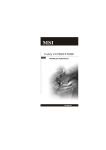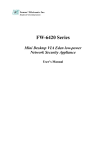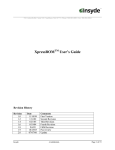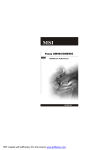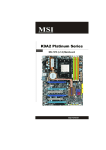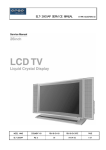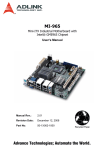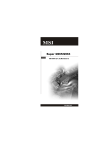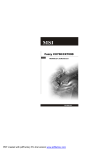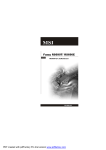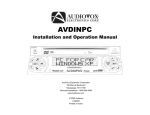Download MSI MS-9801 User`s manual
Transcript
Fuzzy LX800 / LX800D Series MS-9801 (V1.X) Mainboard G52-98011X1 i Copyright Notice Th e material in this d ocument is the in tellectual p rop erty of MICRO-STAR INTERNATIONAL. We take every care in the preparation of this document, but no guarantee is given as to the correctness of its contents. Our products are under continual improvement and we reserve the right to make changes without notice. Trademarks All trademarks are the properties of their respective owners. Intel® and Pentium® are registered trademarks of Intel Corporation. AMD, Athlon™, Athlon™ XP, Thoroughbred™, and Duron™ are registered trademarks of AMD Corporation. NVIDIA, the NVIDIA logo, DualNet, and nForce are registered trademarks or trademarks of NVIDIA Corporation in the United States and/or other countries. PS/2 and OS ®/2 are registered trademarks of International Business Machines Corporation. Windows® 95/98/2000/NT/XP are registered trademarks of Microsoft Corporation. Netware® is a registered trademark of Novell, Inc. Award® is a registered trademark of Phoenix Technologies Ltd. AMI® is a registered trademark of American Megatrends Inc. Revision History Revision V1.0 Revision History First release Date June 2007 Technical Support If a problem arises with your system and no solution can be obtained from the user’s manual, please contact your place of purchase or local distributor. Alternatively, please try the following help resources for further guidance. Visit the MSI website for FAQ, technical guide, BIOS updates, driver updates, an d oth er in forma tion : htt p:// glob al.m si.com.tw /ind ex.p hp? func=faqIndex Contact our technical staff at: http://support.msi.com.tw/ ii Safety Instructions 1. Always read the safety instructions carefully. 2. Keep this User’s Manual for future reference. 3. Keep this equipment away from humidity. 4. Lay this equipment on a reliable flat surface before setting it up. 5. The openings on the enclosure are for air convection hence protects the equipment from overheating. DO NOT COVER THE OPENINGS. 6. Make sure the voltage of the power source and adjust properly 110/220V before connecting the equipment to the power inlet. 7. Place the power cord such a way that people can not step on it. Do not place anything over the power cord. 8. Always Unplug the Power Cord before inserting any add-on card or module. 9. All cautions and warnings on the equipment should be noted. 10. Never pour any liquid into the opening that could damage or cause electrical shock. 11. If any of the following situations arises, get the equipment checked by service personnel: † The power cord or plug is damaged. † Liquid has penetrated into the equipment. † The equipment has been exposed to moisture. † The equipment does not work well or you can not get it work according to User’s Manual. † The equipment has dropped and damaged. † The equipment has obvious sign of breakage. 12. DO NOT LEAVE THIS EQUIPMENT IN AN ENVIRONMENT UNCONDITIONED, STORAGE TEMPERATURE ABOVE 600 C (1400F), IT MAY DAMAGE THE EQUIPMENT. CAUTION: Dan g er of exp losion if b attery is in correctl y rep laced . Replace on ly with the same or equivalent type recommen ded by the manufacturer. iii FCC-B Radio Frequency Interference Statement Th is eq u ip men t h as been tested and found to comply with the limits for a Class B digital device, pursuant to Part 15 of the FCC Rules. These limits are designed to provide reasonable protection against harmful interference in a residential installation. This equipment generates, uses and can radiate radio frequency energy and, if not installed and used in accordance with the instructions, may cause harmful interference to radio communications. However, there is no guarantee that interference will not occur in a particular installation. If this equipment does cause harmful interference to radio or television reception, which can be determined by turning the equipment off and on, the user is encouraged to try to correct the interference by one or more of the measures listed bel ow. † Reorient or relocate the receiving antenna. † Increase the separation between the equipment and receiver. † Connect the equipment into an outlet on a circuit different from that to which the receiver is connected. † Consult the dealer or an experienced radio/television technician for help. Notice 1 The changes or modifications not expressly approved by the party responsible for compliance could void the user’s authority to operate the equipment. Notice 2 Shielded interface cables and A.C. power cord, if any, must be used in order to comply with the emission limits. VOIR LA NOTICE D’INSTALLATION AVANT DE RACCORDER AU RESEAU. Micro-Star International MS-9801 This device complies with Part 15 of the FCC Rules. Operation is subject to the following two conditions: (1) this device may not cause harmful interference, and (2) this device must accept any interference received, including interference that may cause undesired operation. iv WEEE (Waste Electrical and Electronic Equipment) Statement v vi vii CONTENTS Copyright Notice .................................................................................................... iii Trademarks ............................................................................................................ iii Revision History .................................................................................................... iii Technical Support ................................................................................................. iii Safety Instructions ................................................................................................ iii FCC-B Radio Frequency Interference Statement .................................................... v WEEE (Waste Electrical and Electronic Equipment) Statement ................................ v Chapter 1 Getting Started .............................................................................. 1-1 Mainboard Specifications ............................................................................. 1-2 Block Diagram ............................................................................................... 1-4 Board Dimension .......................................................................................... 1-5 Mainboard Layout ........................................................................................ 1-6 Packing Contents ......................................................................................... 1-7 Chapter 2 Hardware Setup ............................................................................. 2-1 Quick Components Guide ............................................................................. 2-2 Memory ....................................................................................................... 2-3 Power Supply .............................................................................................. 2-4 Back Panel ................................................................................................... 2-7 Connectors .................................................................................................. 2-9 Jumpers ..................................................................................................... 2-16 Slots .......................................................................................................... 2-18 Chapter 3 BIOS Setup ...................................................................................... 3-1 Entering Setup ............................................................................................. 3-2 The Main Menu ............................................................................................. 3-4 Standard CMOS Features ............................................................................ 3-6 Advanced BIOS Features ............................................................................ 3-8 Advanced Chipset Features ...................................................................... 3-10 Integrated Peripherals ................................................................................ 3-12 Power Management Setup ......................................................................... 3-14 PNP/PCI Configurations .............................................................................. 3-16 Load Fail-Safe / Optimized Defaults ........................................................... 3-18 Set BIOS Password ................................................................................... 3-19 viii Getting Started Chapter 1 Getting Started Thank you for choosing the Fuzzy LX800 / LX800D Series (MS-9801 v1.X) Mini ITX mainboard from MSI. Based on the innovative AMD® Geode CS5536 controllers for optimal system efficiency, the Fuzzy LX800 / LX800D Series accommodates AMD® Geode LX700/ LX800/LX900 processors and supports two 184-pin 333/400 MHz DDR DIMM to provide the maximum of 2GB memory capacity. Noiseless, Fan less and low power consumption are the advantageous of Fuzzy LX800 / LX800D Series. Due to the IPC special application, Fuzzy LX800 / LX800D Series also provid es two different power SKUs: ATX power and DC-in for your customization. 1-1 MS-9801 Mainboard Mainboard Specifications Embedded Processor - AMD® Geode LX700/LX800/LX900 x86/x87 Compatible Core 433/ 500/600 MHz - 481-terminal PBGA (Pl astic Ball Grid Array) With Intern al Heatspreader - 128K L2 cache Chipset - South Bridge: AMD® Geode CS5536 Companion Device Memory Support - DDR 333/400 SDRAM (2GB Max) - 2 DDR DIMM slots (184pin / 2.5V) Display - AMD LX800 Integrated, Max Shared Memory to 64MB - High Resolution CRT & TFT outputs - Support Analog CRT output - Dual Channel 24 bits LVDS Video Output - Support RCA-Out & S-Video Out (640x480 in PAL and NTSC mode) LAN - 2 Realtek RTL8110SC Chipset, support 10/100/1000Mbps - Support Wake-on-Lan Audio - Realtek® Audio 2 channels AC’97 codec IDE - 1 IDE Channel with ATA 100/66/33 - 1 CF connector Shared With 1 IDE Channel, CF only support in Master mode. -CF supports Slave mode only by using ATA33 IDE cable. Power Connector - 1 ATX 20pin connector for system power (for LX800) - 1 4-pin Internal DC Input Connector (for LX800D) - 1 Din4 12V DC-in Connector (for LX800D) 1-2 Getting Started Connectors Back Panel - 2 RJ-45 LAN jacks - 2 USB 2.0 ports - 1 D-Sub VGA connector - 1 serial port - 1 PS2 keyboard/mouse port - 1 Line-In/Line-Out/Mic-In stacked audio jack - 1 TV out - 1 S-Video out Onboard Pinheaders - 1 USB 2.0 pinheader (2 ports) - 1 parallel port pinheader - 1 front audio pinheader - 1 LVDS connector - 3 RS232 pinheaders - 1 DIO connector - 1 SMBUS connector - 1 Chassis Intrusion Switch connector - 1 CD-in connector - 1 TV out pinheader Slots - 1 Mini PCI Socket - 1 PCI 2.2 compliant slot support 3.3V Only Form Factor - Mini ITX Mounting - 4 mounting holes Environmental Operating Temperature - Temperature: -10oC ~ 70oC - Humidity: 85% RH Storage Temperature - Temperature: -20oC ~ 80oC - Humidity: 25% ~ 90% RH 1-3 MS-9801 Mainboard Block Diagram CRT CRT DR GB Bus LVD S M omory Bus CPU AMD Geode LX Processor DD R DR AM D IM M 400D DR PCI Bus 33MH z PCI Slot Mini -PCI ID E Prim ary IDE ATA-100 CF USB2.0 Co mp a nio n D evice A M D CS 5 5 36 AC 97 Internal Audio AC' 97 Audio External Audio Internal X2 6W Amplifer LPC Bus CO M1 CO M2 1-4 C OM3 C OM4 Getting Started Board Dimension Unit : mm 1-5 MS-9801 Mainboard Mainboard Layout JAMP1 IDE1 JCF_SEL BIOS COM2 COM3 COM 4 F_USB1 IRDA JFP1 J1 BATT + Audio Codec Top : mouse Bottom: keyboard J7 J4 J2 J3 J5 J6 JLPT1 JCI1 T:Line-In M:Line- Out B:Mic-In JCD1 JAUD1 CF1 J66EN_SEL1 AMD Geode CS5536 JLVDS1 SYSFAN1 JTV1 Top: TV Out Bottom: S-Video Out PRJK1 (optional SKU for DC input) ATX1 DIMM1 DIMM2 JLAN1 AMD Geode ALXD800EEXJ2VD MINI PCI1 Top: LAN jack Bottom: USB ports JPW1 (optional SKU for DC input) JPWR1 (optional SKU for DC input) PCI1 JSMB1 Fuzzy LX800 / LX800D Series (MS-9801 v1.X) Mini ITX Mainboard 1-6 (optional SKU for ATX power) Top: Serial Port Bottom: VGA Port Getting Started Packing Contents MSI motherboard MSI Driver/Utility CD User’s Guide Back IO Shield Standard Cable for IDE Devices Parallel and COM Port Bracket 2 COM Ports Bracket * The pictures are for reference only. Your packing contents may vary depending on the model you purchased. 1-7 Hardware Setup Chapter 2 Hardware Setup This chapter provides you with the information about hardware setup procedures. While doing the installation, be careful in holding the components and follow the installation procedures. For some components, if you install in the wrong orientation, the components will not work properly. Use a grounded wrist strap before handling computer comp onen ts. Static el ectricity may damag e th e components. 2-1 MS-9801 Mainboard Quick Components Guide JLVDS1, p.2-14 JAMP1, p.2-10 JAUD1, p.2-10 J2~J7, p.2-16 COM2~4, p.2-13 JCI1, p.2-10 JLPT1, p.2-11 JCD1, p.2-14 CLR_CMOS1, IDE1, p.2-17 p.2-9 J1, p.2-11 JCF_SEL, p.2-8 F_USB1, p.2-13 IRDA, p.2-15 JFP1, p.2-12 CF1, p.2-9 Back Panel, p.2-7 DIMM1,2, p.2-3 J66EN_SEL1, p.2-17 SYSFAN1, p.2-11 ATX1, p.2-4 JPWR1, p.2-5 PRJK1, p.2-4 JPW1, p.2-5 JTV1, p.2-15 2-2 MINIPCI1, p.2-19 PCI1, p.2-18 JSMB1, p.2-15 Hardware Setup Memory The mainboard provides two 184-pin non-ECC DDR 333/400 DIMM slot and supports up to 2GB system memory. DDR 184-pin, 2.5V 40x2=80 pin 52x2=104 pin Installing DDR Modules 1. The memory module has only one notch on the center and will only fit in the right orientation. 2. Insert the memory module vertically into the DIMM slot. Then push it in until the golden finger on the memory module is deeply inserted in the DIMM slot. Important You can barely see the golden finger if the memory module is properly inserted in the DIMM slot. 3. The plastic clip at each side of the DIMM slot will automatically close. Volt Notch 2-3 MS-9801 Mainboard Power Supply ATX 20-Pin System Power Connector: ATX1(optional SKU for ATX power) This connector allows you to connect to an ATX power supply. To connect to the ATX power supply, make sure the plug of the power supply is inserted in the proper orientation and the pins are aligned. Then push down the power supply firmly into the connector. ATX1 Pin Definition ATX1 11 20 1 10 PIN SIGNAL PIN SIGNAL 1 2 3 4 5 6 7 8 9 3.3V 3.3V GND 5V GND 5V GND PW_OK 5V_SB 10 12V 11 12 13 14 15 16 17 18 19 20 3.3V -12V GND PS_ON GND GND GND -5V 5V 5V Din4 12V DC-in Connector: PRJK1 (optional SKU for external DCin) This connector allows you to connect to an external DC12V power supply. To connect to the DC12V power supply, make sure the plug of the power supply is inserted in the proper orientation and the polarity of pins are matched. PRJK1 Definition 4 3 2 1 2-4 Hole SIGNAL 1 2 3 4 GND GND 12V 12V Hardware Setup 4-Pin Internal Power Connector: JPW1 (optional SKU for internal DC-in) This connector allows you to connect to an internal DC12V power supply. To connect to the DC12V power supply, make sure the plug of the power supply is inserted in the proper orientation and the polarity of pins are matched. JPW 1 Pin Definition JPW1 2 1 4 3 PIN SIGNAL 1 2 3 4 GND GND 12V 12V Disk Drive Power: JPWR1 (optional SKU for DC input) This connector delivers power to IDE devices. JPWR1 Definition 4 3 2 1 Hole SIGNAL 1 2 3 4 5V GND GND 12V 2-5 MS-9801 Mainboard Power Consumption Power Supply : LEMACS Model : AX2-5300FB-2S(V) AC INPUT : 115V230V 60/50Hz 9/5A FUSE RATING : 6A/250V DC OUTPUT : 300W +5V 30A +12V 12A +3.3V 14A, -5V 0.5A -12V 0.5A +5VSB 1.5A +5V AND +3.3V TOTAL MAX : 150W A. Playing DVD - Power DVD 7.0 Main Board +3.3V Main Board +5V Main Board 5VSB Main Board +12V Main Board Power Consumption Measured Voltage 3.4054 5.0959 5.0808 11.762 Measured Amp. 0.713 0.037 0.067 0.584 Watts 2.4281 0.1885 0.3404 6.8690 9.8260 Measured Amp. 0.712 0.032 0.067 0.552 Watts 2.4246 0.1639 0.3404 6.4170 9.3459 Measured Voltage 3.3993 5.1177 5.0808 11.66 Measured Amp. 1.606 0.038 0.063 0.586 Watts 5.4593 0.1945 0.3201 6.8328 12.8066 Measured Voltage 3.4054 5.1238 5.0811 11.619 Measured Amp. 0.724 0.043 0.069 0.46 Watts 2.4655 0.2203 0.3506 5.3447 8.3812 Measured Voltage 0 0.3965 5.0615 0.0115 Measured Amp. 0 0 0.225 0 Watts 0.0000 0.0000 1.1388 0.0000 1.1388 B. Playing MP3 - Media Player Main Board +3.3V Main Board +5V Main Board 5VSB Main Board +12V Main Board Power Consumption Measured Voltage 3.4053 5.1219 5.0811 11.625 C. Running Network Application - Files Copy Main Board +3.3V Main Board +5V Main Board 5VSB Main Board +12V Main Board Power Consumption D. Idle Main Board +3.3V Main Board +5V Main Board 5VSB Main Board +12V Main Board Power Consumption E. S3 Mode Main Board +3.3V Main Board +5V Main Board 5VSB Main Board +12V Main Board Power Consumption 2-6 Hardware Setup Back Panel Line-In M ouse Serial Port RCA out LAN Port Line-Out LAN Port Mic-In Keyboard VGA Port S-Videoout USB Ports Audio Port Connectors These audio connectors are used for audio devices. You can differentiate the color of the audio jacks for different audio sound effects. Blue audio jack - Line In is used for external CD player, tapeplayer or other audio devices. Green audio jack - Line Out, is a connector for speakers or headphones. Pink audio jack - Mic In, is a connector for microphones. Mouse/Keyboard Connector The standard PS/2® mouse/keyboard DIN connector is for a PS/2® mouse/keyboard. Serial Port Connector The serial port is a 16550A high speed communications port that sends/ receives 16 bytes FIFOs. You can attach a serial mouse or other serial devices directly to the connector. VGA Connector The DB15-pin female connector is provided for VGA monitors. RCA Out The RCA connector allows users to connect display devices for composite video input/output. Composite video, also called baseband video or RCA video, is the analog waveform that conveys the image data in a conventional NTSC and PAL television signal. Composite video con tains chrominance (hue and saturation) and luminance (brightness) information, along with synchronization and blanking pulses, all together in a single signal. S-Video Out The S-Video connector allows users to connect display devices for component video input/output. S-Video (Super-Video, sometimes referred to as Y/C Video, or component video) is a video signal transmission in which the luminance signal and the chrominance signal are transmitted separately to achieve superior picture clarity. The luminance signal (Y) carries brightness information, which defines the black and white portion, and the chrominance signal (C) carries color information, which defines hue and saturation. An S-Video connection brings better video quality than a composite/RCA connection. 2-7 MS-9801 Mainboard LAN (RJ-45) Jacks The standard RJ-45 jacks are for connection to Local Area Network (LAN). You can connect network cables to them. 100M Cable Plug-in 1000M Cable Plug-in Link Indicator Le ft LED Right LED Active LED 100M/1000M Speed LED Yellow Green/Orange No Transmission OFF OFF Transition Yellow(Blinking) OFF No Transmission OFF Green(Lighting) Transition Yellow(Blinking) Green(Lighting) No Transmission OFF Orange(Lighting) Transition Yellow(Blinking) Orange(Lighting) OFF OFF LED Color 10M Cable Plug-in Activity Indicator In S3/S4/S5 Standby State USB Connectors The OHCI (Open Host Controller Interface) Universal Serial Bus root is for attaching USB devices such as keyboard, mouse, or other USB-compatible devices. 2-8 Hardware Setup Connectors ATA100 Hard Disk Connector: IDE1 The mainboard has a 32-bit Enhanced PCI IDE and Ultra DMA 33/66/100 controller that provides PIO mode 0~4, Bus Master, and Ultra DMA 33/66/100 function. You can connect hard disk drives, CD-ROM and other IDE devices. The Ultra ATA100 interface boosts data transfer rates between the computer and the hard drive up to 100 megabytes (MB) per second. IDE1 Compact Flash Card Slot: CF1 This Compact Flash slot shares one channel of the IDE controller. You can install one Compact Flash typeI / type II device. CF1 CF Mode Selecting Jumper: JCF_SEL1 This jumper is used to select Master/ Slave mode of the CF device. JCF_SEL1 1 1 1 3 Master 3 Slave Important * The CF1 slot and the IDE1 connector shares and uses the same channel, CF1 and IDE1 can support up to 2 IDE devices without CF device or 1 IDE device with 1 CF device. * If you install two IDE devices, you must configure the second drive to Slave mode by setting its jumper. Refer to the hard disk documentation supplied by hard disk vendors for jumper setting instructions. * If you install one IDE device with ATA100 IDE cable and one CF device, you must configure the CF drive to Master mode by setting jumper JCF_SEL1. CF only support Master mode by using the ATA100 IDE cable. * CF only support Slave mode by using ATA33 IDE cable. 2-9 MS-9801 Mainboard Audio Amplifier Connector: JAMP1 The 5W JAMP1 is used to connect audio amplifiers to enhance audio performance. Pin Definition JAMP1 1 PIN SIGNAL 1 AMP_L- 2 3 4 AMP_L+ AMP_RAMP_R+ Front Panel Audio Connector: JAUD1 The JAUD1 front panel audio connector allows you to connect the front panel audio and is compliant with Intel® Front Panel I/O Connectivity Design Guide. JAUD1 9 1 10 2 JAUD1 Pin Definition PIN SIGNAL DESCRIPTION 1 2 3 4 5 6 7 8 9 10 AUD_MIC AUD_GND AUD_MIC_BIAS AUD_VCC AUD_FPOUT_R AUD_RET_R HP_ON KEY AUD_FPOUT_L AUD_RET_L Front panel microphone input signal Ground used by analog audio circuits Microphone power Filtered +5V used by analog audio circuits Right channel audio signal to front panel Right channel audio signal return from front panel Reserved for future use to control headphone amplifier No pin Left channel audio signal to front panel Left channel audio signal return from front panel Important If you don’t want to connect to the front audio header, pins 5 & 6, 9 & 10 have to be jumpered in order to have signal output directed to the rear audio ports. Otherwise, the Line-Out connector on the back panel will not function. 2-10 9 5 10 6 Hardware Setup Chassis Intrusion Switch Connector: JCI1 This connector connects to a 2-pin chassis switch. If the chassis is opened, the switch will be short. The system will record this status and show a warning message on the screen. To clear the warning, you must enter the BIOS utility and clear the record. JCI1 CHASSIS GND 1 2 Digital IO Connector: J1 The J1 connects to the General-Purpose Input/Output (GPIO) peripheral module. J1 Pin Definition J1 10 2 9 1 PIN SIGNAL PIN SIGNAL 1 GND 2 VCC5F 3 N_GPO3 4 N_GPO1 5 N_GPO2 6 N_GPO0 7 N_GPI3 8 N_GPI1 9 N_GPI2 10 N_GPI0 System Fan Power Connectors: SYSFAN1 The fan power connectors support system cooling fan with +12V. When connecting the wire to the connectors, always take note that the red wire is the positive and should be connected to the +12V, the black wire is Ground and should be connected to GND. If the mainboard has a System Hardware Monitor chipset on-board, you must use a specially designed fan with speed sensor to take advantage of the CPU fan control. SYSFAN1 SENSOR +1 2V GND 2-11 MS-9801 Mainboard Front Panel Connector: JFP1 The mainboard provides one front panel connector for electrical connection to the front panel switches and LEDs. The JFP1 is compliant with Intel® Front Panel I/O Connectivity Design Guide. JFP1 HDD + LED Reset Switch + 1 9 2 Power LED + Power - Switch 10 JFP1 Pin Definition PIN SIGNAL DESCRIPTION 1 2 3 4 5 6 7 8 9 HD_LED + FP PWR/SLP HD_LED FP PWR/SLP RST_SW PWR_SW + RST_SW + PWR_SW RSVD_DNU Hard disk LED pull-up MSG LED pull-up Hard disk active LED MSG LED pull-up Reset Switch low reference pull-down to GND Power Switch high reference pull-up Reset Switch high reference pull-up Power Switch low reference pull-down to GND Reserved. Do not use. Parallel Port Header: JLPT1 The mainboard provides a 26-pin header for connection to an optional parallel port bracket. The parallel port is a standard printer port that supports Enhanced Parallel Port (EPP) and Extended Capabilities Parallel Port (ECP) mode. JLPT1 26 25 2 1 PIN SIGNAL PIN SIGNAL PIN SIGNAL PIN SIGNAL 1 RSTB# 2 AFD# 15 PRND6 16 GND 3 5 7 9 11 13 PRND0 PRND1 PRND2 PRND3 PRND4 PRND5 4 6 8 10 12 14 ERR# PINIT# LPT_SLIN# GND GND GND 17 19 21 23 25 PRND7 ACK# BUSY PE SLCT 18 20 22 24 26 GND GND GND GND Key (No Pin) 2-12 Hardware Setup Front USB Connector: F_USB1 The mainboard provides one USB 2.0 pinheader that is compliant with Intel ® I/O Connectivity Design Guide. USB 2.0 technology increases data transfer rate up to a maximum throughput of 480Mbps, which is 40 times faster than USB 1.1, and is ideal for connecting high-speed USB interface peripherals such as USB HDD, digital cameras, MP3 players, printers, modems and the like. F_USB1 2 1 10 9 Pin Definition PIN SIGNAL PIN SIGNAL 1 VCC 2 VCC 3 USB0- 4 USB1- 5 USB0+ 6 USB1+ 7 GND 8 GND 9 Key (no pin) 10 USBOC Important Note that the pins of VCC and GND must be connected correctly to avoid possible damage. Serial Port Connector: COM 2, COM3, COM4 The mainboard provides three 9-pin headers as serial port COM2, COM3 and COM4. These ports are 16550A high speed communication port that sends/receives 16 bytes FIFOs. You can attach a serial mouse or other serial devices directly to it. Pin Definition 9 8 2 1 COM 2 / COM3 / COM4 PIN 1 2 3 4 5 6 7 8 9 SIGNAL DESCRIPTION DCD SIN SOUT DTR GND DSR RTS CTS RI Data Carry Detect Serial In or Receive Data Serial Out or Transmit Data Data Terminal Ready Ground Data Set Ready Request To Send Clear To Send Ring Indicate 2-13 MS-9801 Mainboard CD-In Connector: JCD1 The connector is for CD-ROM audio connector. JCD1 R GND L LVDS Flat Panel Connector: JLVDS1 The LVDS (Low Voltage Differential Signal) connector provides a digital interface typically used with flat panels. After connecting an LVDS interfaced flat panel to the JLVDS1, be sure to check the panel datasheet and set the J1 LVDS Power Selection Jumper to a proper voltage. SIGNAL JLVDS1 40 39 2-14 2 1 PIN SIGNAL +12V 2 1 +12V +12V GND 4 3 +12V 6 5 +12V GND 8 7 VCC5 LCD_VDD LDDC_DATA 10 12 9 11 LCD_VDD LDDC_CLK LVDS_VDDEN 14 13 L_BKLTCTL GND 16 15 L_BKLTEN LA_DATA0 LA_DATA1 18 20 17 19 LA_DATA0# LA_DATA1# LA_DATA2 22 21 LA_DATA2# LA_CLK 24 23 LA_CLK# LA_DATA3 26 25 LA_DATA3# GND 28 27 GND LB_DATA0 LB_DATA1 30 32 29 31 LB_DATA0# LB_DATA1# LB_DATA2 34 33 LB_DATA2# LB_CLK 36 35 LB_CLK# LB_DATA3 38 37 LB_DATA3# GND 40 39 GND Hardware Setup TV-Out Connector: JTV1 The mainboard provides a TV-Out connector. JTV1 Pin Definition JTV1 2 5 1 Pin Description Pin Description 1 TVGND 2 LCVBS 3 LY 4 TVGND 5 LC 6 Key (no pin ) IrDA Infrared Module Header: IRDA1 The connector allows you to connect to IrDA Infrared module. You must configure the setting through the BIOS setup to use the IR function. IRDA1 is compliant with Intel® Front Panel I/O Connectivity Design Guide. Pin Definition IRDA1 1 2 5 6 Pin Signal 1 2 3 4 5 6 NC Key (no pin) VCC5 GND IRTX IRRX SMBus Connector: JSMB1 The connector allows you to connect to SMBus devices. Pin Definition JSMB1 4 1 Pin Signal 1 VCC5F 2 SMBCLK 3 GND 4 SMBDATA- 2-15 MS-9801 Mainboard Jumpers COM Port Power Jumpers: J2, J3, J5, J6 These jumpers specify the operation voltage of the serial port COM1~4. Pin Definition J2,J3,J5,J6 1 Pin Signal 1 VCC12F 2 VCC_COM 3 VCC5F 1 1 3 3 12V 5V AT/ATX Power Jumper: J4 This jumper is used to select AT or ATX power. J4 1 1 1 3 AT 3 ATX LCD Power Source Jumper: J7 This jumper is used to select the power source of LCD. Pin Definition J7 1 Pin Signal 1 VCC3 2 LCD_SRC (default VCC3) 3 VCC5 1 3 3.3V 2-16 1 3 5V Hardware Setup PCI Frequency Jumper: J66EN_SEL1 This jumper is used to select the frequency of PCI bus. J4 3 1 3 1 1 33MHz 66MHz (default) Clear CMOS Jumper: CLR_CMOS1 There is a CMOS RAM onboard that has a power supply from external battery to keep the data of system configuration. With the CMOS RAM, the system can automatically boot OS every time it is turned on. If you want to clear the system configuration, set the CLR_CMOS1 (Clear CMOS Jumper ) to clear data. 1 1 1 CLR_CMOS1 3 Keep Data 3 Clear Data Important You can clear CMOS by shorting 2-3 pin while the system is off. Then return to 1-2 pin position. Avoid clearing the CMOS while the system is on; it will damage the mainboard. 2-17 MS-9801 Mainboard Slots PCI (Peripheral Component Interconnect) Slot The PCI slot supports LAN cards, SCSI cards, USB cards, and other add-on cards that comply with PCI specifications. At 32 bits and 33 MHz, it yields a throughput rate of 133 MBps. Warning This PCI slot can only support the 3.3V PCI card. PCI Slot PCI Interrupt Request Routing The IRQ, acronym of interrupt request line and pronounced I-R-Q, are hardware lines over which devices can send interrupt signals to the microprocessor. The PCI IRQ pins are typically connected to the PCI bus pins as follows: 32-bit PCI1 Order 1 Order 2 Order 3 Order 4 INT A# INT B# INT C# INT D# Important When adding or removing expansion cards, make sure that you unplug the power supply first. Meanwhile, read the documentation for the expansion card to configure any necessary hardware or software settings for the expansion card, such as jumpers, switches or BIOS configuration. 2-18 Hardware Setup Mini PCI Slot This is a 32 bits, 33 MHz and 133 MBps PCI slot, only select the MiniPCI adapters can be installed. Mini PCI Slot Installing Mini PCI Cards 1. Insert the card at an angle of 45 degrees into the Mini PCI slot, Line up the notch in the card with the small tab in the slot and slide the card into the slot until the golden finger is almost invisible. 2. Push the Mini PCI card down until the two snaps on either side of the card lock into place. Notch 45o Lock 2-19 MS-9801 Mainboard Removing Mini PCI Cards If you need to remove a card in the Mini PCI slot, spread the tabs in the slot away from the notches in the card. The card should pop up slightly. Lift the card to a 45-degree angle and then gently slide the card out of the slot. 2-20 BIOS Setup Chapter 3 BIOS Setup This chapter provides information on the BIOS Setup program and allows you to configure the system for optimum use. You may need to run the Setup program when: ² An error message appears on the screen during the system booting up, and requests you to run SETUP. ² You want to change the default settings for customized features. 3-1 MS-9801 Mainboard Entering Setup Power on the computer and the system will start POST (Power On Self Test) process. When the message below appears on the screen, press <DEL> key to enter Setup. Press DEL to enter SETUP If the message disappears before you respond and you still wish to enter Setup, restart the system by turning it OFF and On or pressing the RESET button. You may also restart the system by simultaneously pressing <Ctrl>, <Alt>, and <Delete> keys. Important 1. The items under each BIOS category described in this chapter are under continuous update for better system performance. Therefore, the description may be slightly different from the latest BIOS and should be held for reference only. 2. Upon boot-up, the 1st line appearing after the memory count is the BIOS version. It is usually in the format: W9081AMS V1.0 081006 where: 1st digit refers to BIOS maker as A = AMI, W = AWARD, and P = PHOENIX. 2nd - 5th digit refers to the model number. 6th digit refers to the chipset. 7th - 8th digit refers to the customer as MS = all standard customers. V1.0 refers to the BIOS version. 081006 refers to the date this BIOS was released. 3-2 BIOS Setup Control Keys <↑> <↓> <←> <→> <Enter> <Esc> <+/PU> <-/PD> <F10> Move to the previous item Move to the next item Move to the item in the left hand Move to the item in the right hand Select the item Jumps to the Exit menu or returns to the main menu from a submenu Increase the numeric value or make changes Decrease the numeric value or make changes Save all the CMOS changes and exit Getting Help After entering the Setup menu, the first menu you will see is the Main Menu. Main Menu The main menu lists the setup functions you can make changes to. You can use the arrow keys ( ↑↓ ) to select the item. The on-line description of the highlighted setup function is displayed at the bottom of the screen. Sub-Menu If you find a right pointer symbol (as shown in the right view) appears to the left of certain fields that means a submenu can be launched from this field. A sub-menu contains additional options for a field parameter. You can use arrow keys ( ↑↓ ) to highlight the field and press <Enter> to call up the sub-menu. Then you can use the control keys to enter values and move from field to field within a submenu. If you want to return to the main menu, just press the <Esc >. General Help <F1> The BIOS setup program provides a General Help screen. You can call up this screen from any menu by simply pressing <F1>. The Help screen lists the appropriate keys to use and the possible selections for the highlighted item. Press <Esc> to exit the Help screen. 3-3 MS-9801 Mainboard The Main Menu Standard CMOS Features Use this menu for basic system configurations, such as time, date etc. Advanced BIOS Features Use this menu to setup the items of AMI® special enhanced features. Advanced Chipset Features Use this menu to change the values in the chipset registers and optimize your system’s performance. Integrated Peripherals Use this menu to specify your settings for integrated peripherals. Power Management Setup Use this menu to specify your settings for power management. PNP/PCI Configurations This entry appears if your system supports PnP/PCI. Load Fail-Safe Defaults Use this menu to load the default values set by the mainboard manufacturer. Load Optimized Defaults Use this menu to load the default values set by the mainboard manufacturer specifically for optimal performance of the mainboard. 3-4 BIOS Setup Set Supervisor Password Use this menu to set the password for supervisors. Set User Password Use this menu to set the password for users. Save & Exit Setup Save changes to CMOS and exit setup. Exit Without Saving Abandon all changes and exit setup. 3-5 MS-9801 Mainboard Standard CMOS Features The items in Standard CMOS Features Menu includes some basic setup items. Use the arrow keys to highlight the item and then use the <PgUp> or <PgDn> keys to select the value you want in each item. Date (mm:dd:yy) This allows you to set the system to the date that you want (usually the current date). The format is <day><month> <date> <year>. day Day of the week, from Sun to Sat, determined by BIOS. Read-only. month The month from Jan. through Dec. date The date from 1 to 31 can be keyed by numeric function keys. year The year can be adjusted by users. Time (hh:mm:ss) This allows you to set the system time that you want (usually the current time). The time format is <hour> <minute> <second>. IDE Primary Master/ Slave Press <Enter> to enter the sub-menu. IDE HDD Auto-Detection Press Enter to auto-detectthe HDD on this channel. Ifdetection is successful, itfills the remaining fields onthis menu. IDE Primary Master/Slave Selecting “manua” lets you set the remaining fields onthis screen. Selects the type of fixed disk. “User Type” will let you select thenumber of cylinders, heads, etc. Note:PRECOMP=65535 means NONE! 3-6 BIOS Setup Access M ode Choose the access mode forthis hard disk. Capacity Disk drive capacity(Approximated). Note that this size is usually slightly greater than the size of a formatted disk given by adisk checking program. Cylinder Set the number of cylinders for this hard disk. Head Set the number ofread/write heads. Precomp Warning: Setting avalue of 65535 means no hard disk. Landing Zone Number of landing zone. Sector Number of sectors per track. Video Select the default video device. Halt On Select the situation in which you want the BIOS to stop the POST process and notify you. Base Memory Displays the amount of conventional memory detected during boot up. Extended Memory Displays the amount ofextended memory detectedduring boot up. Total Memory Displays the total memoryavailable in the system. 3-7 MS-9801 Mainboard Advanced BIOS Features Hard Disk Boot Priority Press [Enter] to enter a sub menu which shows every current hard drive installed. Use [PageUp] or [PageDown] key to select the first boot hard disk. First/Second/Third Boot Device & Boot From Other Device The items allow you to set the sequence of boot devices where BIOS attempts to load the disk operating system. Boot Up NumLock Status This setting is to set the Num Lock status when the system is powered on. Setting to [On] will turn on the Num Lock key when the system is powered on. Setting to [Off] will allow users to use the arrow keys on the numeric keypad. Security Option Select whether the password is required every time the system boots or only when you enter setup. System The system will not boot and access to Setup will be denied if the correct password is not entered at the prompt. Setup The system will boot, but access to Setup will be denied if the correct password is not entered at the prompt. Note: To disable security, select PASSWORD SETTING at Main Menu and then you will be asked to enter password. Do not type anything and just press<Enter>, it will disable security. Once the security is disabled, the system will boot and you can enter Setup freely. 3-8 BIOS Setup Small Logo(EPA) Show This item enables you to show the EPA logo (brand specific graphics) on the bootup screen. Settings are: [Disabled] Shows the normal POST screen at boot. [Enabled] Shows a still image (EPA logo) on the screen at boot.ot. Chassis Intrusion Detect The field enables or disables the feature of recording the chassis intrusion status and issuing a warning message if the chassis is once opened. To clear the warning message, set the field to [Reset]. The setting of the field will automatically return to [Enabled] later. 3-9 MS-9801 Mainboard Advanced Chipset Features CPU Frequency This setting allows you to specify the CPU frequency. Memory Frequency This setting allows you to specify the memory frequency. CAS Latency This controls the timing delay (in clock cycles) before SDRAM starts a read command after receiving it. Smaller clocks increase system performance while bigger clocks provide more stable system performance. Video Memory Size The field specifies the size of system memory allocated for video memory. Output display This setting allows you to select the type of output display. VT1622 Support VT1622 support TV-Out with 640x480 resolution; TV modes of NTSC, PAL. Flat Panel Configuration Press <Enter> to enter the sub-menu. Flat Panel Type Select the type of Flat Panel Monitor. 3-10 BIOS Setup Resolution Specify the resolution of the monitor. Data Bus Type Select the type of Date Bus. Refresh Rate Specify the refresh rate of the monitor. HSYNC Polarity Select the active polarity of the HSYNC signal to the monitor. VSYNC Polarity Active Select the active polarity of the VSYNC signal to the monitor. SHFCLK Active Period Select the active period of the SHFCHK signal. LP Active Period Select the active period of the LDE/MOD (LP) signal. Onboard Audio The field allows you to enable/disable the onboard audio. Onboard USB1.1 The field allows you to enable/disable the onboard USB1.1. Onboard USB2.0 The field allows you to enable/disable the onboard USB2.0. 3-11 MS-9801 Mainboard Integrated Peripherals Onboard Serial Port 1/ 2/ 3/ 4, Serial Port 3/ 4 Use IRQ Select an address and corresponding interrupt for the serial port 1/ 2/ 3/ 4. Serial Port2 Mode Select This setting allows you to specify the operation mode for serial port 2. [Normal] RS-232C Serial Port [IrDA] IrDA-compliant Serial Infrared Port [ASKIR] Amplitude Shift Keyed Infrared Port RxD, TxD Active This setting controls the receiving and transmitting speed of the IR peripheral in use. IR Transmission Delay This setting determines whether the IR transmission rate will be delayed while converting to receiving mode. UR2 Duplex Mode This setting controls the operating mode of IR transmission/reception. Under [Full] Duplex mode, synchronous, bi-directional transmission/reception is allowed. Under [Half] Duplex mode, only asynchronous, bi-directional transmission/reception is allowed. Use IR Pins Consult your IR peripheral documentation to select the correct setting of the TxD and RxD signals. 3-12 BIOS Setup Onboard Parallel Port Select an address and corresponding interrupt for the parallet port. Parallel Port Mode To operate the onboard parallel port as Standard Parallel Port only, choose [SPP]. To operate the onboard parallel port in the EPP mode simultaneously, choose [EPP]. By choosing [ECP], the onboard parallel port will operate in ECP mode only. Choosing [ECP + EPP] will allow the onboard parallel port to support both the ECP and EPP modes simultaneously. EPP Mode Select Select the EPP mode. ECP Mode Use DMA Select the DMA channel for ECP mode. 3-13 MS-9801 Mainboard Power Management Setup ACPI Function This item is to activate the ACPI (Advanced Configuration and Power Management Interface) Function. ACPI Suspend Type This item specifies the power saving modes for ACPI function. If your operating system supports ACPI, such as Windows 2000/ XP , you can choose to enter the Standby mode in S1 or S3 fashion through the setting of this field. S1 sleep mode is a low power state. In this state, no system context is lost (CPU or chipset) and hardware maintains all system context. S3 sleep mode is a lower power state where the in formation of system configuration and open applications/files is saved to main memory that remains powered while most other hardware components turn off to save energy. The information stored in memory will be used to restore the system when a “wake up” event occurs. Power Management This item is to select Power Management Function. PME Event Function You may disable activity monitoring of some common I/O events and interrupt requests so they do not wake up the system. The default wake-up event is keyboard activity. When On (or named, in the case of LPT & COM), any activity from one of the listed system peripheral devices or IRQs wakes up the system. A power-management (PM) event awakens the system from, or resets activity timers for, Suspend mode. You can disable monitoring of common interrupt requests so they do not generate PM events. 3-14 BIOS Setup Soft-Off by PWR-BTTN When [Enabled], turning the system off with the on/off button places the system in a very low-power-usage state, with only enough circuitry receiving power to detect power button activity or Resume by Ring activity. Power-On by Alarm When you select [Enabled], fields appear that let you set the alarm that returns the system to Full On state. Time (hh:mm:ss) Alarm The field specifies the time for Power-On by Alarm. Format is <hour><minute> <second>. PWRON After PWR-Fail This item specifies whether your system will reboot after a power failure or interrupt occurs. Settings are: [Off] Always leaves the computer in the power off state. [On] Always leaves the computer in the power on state. [Last State] Restores the system to the status before power failure or interrupt occurred. 3-15 MS-9801 Mainboard PNP/PCI Configurations This section describes configuring the PCI bus system and PnP (Plug & Play) feature. PCI, or Peripheral Component Interconnect, is a system which allows I/O devices to operate at speeds nearing the speed the CPU itself uses when communicating with its special components. This section covers some very technical items and it is strongly recommended that only experienced users should make any changes to the default settings. PNP OS Installed When set to [Yes], BIOS will only initialize the PnP cards used for booting (VGA, IDE, SCSI). The rest of the cards will be initialized by the PnP operating system like Windows 98. When set to [No], BIOS will initialize all the PnP cards. So, select [Yes] if your operating system is Plug & Play aware. Init Display First This item specifies which VGA card is your primary graphics adapter. Reset Configuration Data The ESCD (Extended System Configuration Data) NVRAM (Non-volatile Random Access Memory) is where the BIOS stores resource information for both PNP and nonPNP devices in a bit string format. When the item is set to [Enabled], the system will reset ESCD NVRAM right after the system is booted up and then set the setting of the item back to [Disabled] automatically. Resources Controlled By The Award Plug and Play BIOS has the capacity to automatically configure all of the boot and Plug and Play compatible devices. However, this capability means absolutely nothing unless you are using a Plug and Play operating system such as Windows® 98/2000. If you set this field to [Manual], choose specific resources by going into each sub-menu that follows this field. 3-16 BIOS Setup IRQ Resource Press <Enter> to enter the sub-menu. IRQ 3/4/5/7/9/10/11/14/15 These items specify the bus where the specified IRQ line is used. The settings determine if AMIBIOS should remove an IRQ from the pool of available IRQs passed to devices that are configurable by the system BIOS. The available IRQ pool is determined by reading the ESCD NVRAM. If more IRQs must be removed from the IRQ pool, the end user can use these settings to reserve the IRQ by assigning an [Reserved] setting to it. Onboard I/O is configured by AMIBIOS. All IRQs used by onboard I/O are configured as [Available]. If all IRQs are set to [Reserved], and IRQ 14/15 are allocated to the onboard PCI IDE, IRQ 9 will still be available for PCI and PnP devices. Important IRQ (Interrupt Request) lines are system resources allocated to I/O devices. When an I/O device needs to gain attention of the operating system, it signals this by causing an IRQ to occur. After receiving the signal, when the operating system is ready, the system will interrupt itself and perform the service required by the I/O device. M emory Resource Press <Enter> to enter the sub-menu. Reserved M emory Base These items specify the reserved memory base. Reserved Memory Length These items specify the reserved memory length. 3-17 MS-9801 Mainboard Load Fail-Safe / Optimized Defaults The two options on the main menu allow users to restore all of the BIOS settings to the default Fail-Safe or Optimized values. The Optimized Defaults are the default values set by the mainboard manufacturer specifically for optimal performance of the mainboard. The Fail-Safe Defaults are the default values set by the BIOS vendor for stable system performance. When you select Load Fail-Safe Defaults, a message as below appears: Pressing [OK] loads the BIOS default values for the most stable, minimal system performance. When you select Load Optimized Defaults, a message as below appears: Pressing [OK] loads the default factory settings for optimal system performance. 3-18 BIOS Setup Set BIOS Password When you select this function, a message as below will appear on the screen: Type the password, up to six characters in length, and press <Enter>. The password typed now will replace any previously set password from CMOS memory. You will be prompted to confirm the password. Retype the password and press <Enter>. You may also press <Esc> to abort the selection and not enter a password. To clear a set password, just press <Enter> when you are prompted to enter the password. A message will show up confirming the password will be disabled. Once the password is disabled, the system will boot and you can enter Setup without entering any password. When a password has been set, you will be prompted to enter it every time you try to enter Setup. This prevents an unauthorized person from changing any part of your system configuration. 3-19






















































